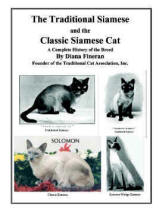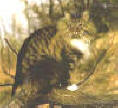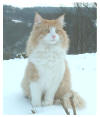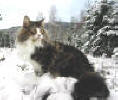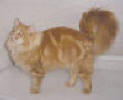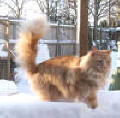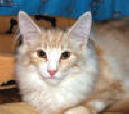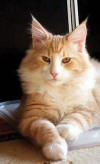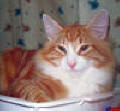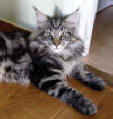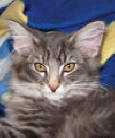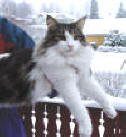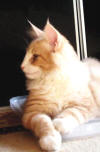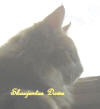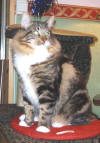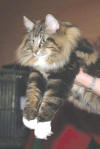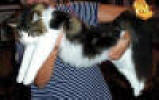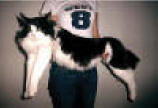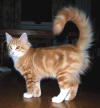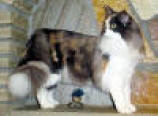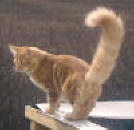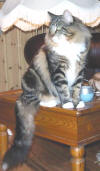HISTORY AND
PROFILE OF
THE TRADITIONAL NORWEGIAN FOREST CAT ©
Copyright Diana
Fineran March 1, 2005
(PLEASE CLICK ON THE PHOTOS TO ENLARGE)
Cats arrived in Norway by around AD 1000,
at which time Vikings maintained trade routes with the Byzantine East. Proof
that cats were traded directly from Byzantium to Norway comes from Norwegian cat
populations with coat colors common in Turkey but rare across Europe. It is
possible that the Traditional Norwegian Forest Cat traces its ancestry back to
longhaired Turkish Angoras. Some time about 4000 years ago these cat’s forebears
came out of the Scandinavian forests. Theoretically these cats explored with the
Vikings, always protecting grain stocks on land and on ocean voyages with Lief
Erickson or his contemporaries. Possibly they left their descendants in North
America to pass on their characteristics to the Traditional Maine Coon and the
Long Haired Manx. In the post Viking age the horrible disease called Black Death
hit Norway. Every person in many small villages in small valleys died. The
Traditional Norwegian Forest Cats were left on their own. Many in Norway believe
it was during this time that the Traditional Norwegian Forest Cat became what
they are today. Only the strongest ones could survive alone, especially in the
harsh winters. It is thought the reason they developed good climbing skills was
because their food source was in the trees. Birds and their young were
something the cats were very good at catching. Neither the bears, wolfs or the
lynx ate much of the birds. The Traditional Norwegian Forest Cat developed the
skill of climbing down trees head first, allowing them to look underneath them
to see if any dangerous animals who could kill them were under the tree as they
climbed down. On the ground they were susceptible to wolves, fox or lynx. They
were safe in the trees. The harsh Scandinavian winter favored large, longhaired
cats, which became popular with farmers. Their ancestry is as farm cats weighing
7 to 30 pounds. Their size, big bones, large paws, sharp hearing and alert eyes
helped them hunt and survive. Claws that were extra strong and rounded gave them
good grip when climbing. Long legs helped them in the deep snow. Norwegians
claim the cat has always been around, because they have been featured in folk
tales and mythology for centuries there.
The Traditional Norwegian Forest Cat was in
danger of being lost as a distinct breed due to mixing with the Norwegian
domestic shorthairs. It was not regarded as a singular breed until the 1930’s,
when Norwegian breeders realized the plight of the breed. WWII put their efforts
on hold for a while until planned breeding began in the 1970’s. The result was
the Traditional Norwegian Forest Cat was officially given the distinction of
being named the Official Cat of Norway by the late King Olaf.
In Norway, Truls was the male who the
Norwegian Breed Standard was written after. He was big and strong and had a
proud bearing in his body language. A Judge by the name of Molly Oliver was
against the recognition of this breed, believing it was just a long-haired house
cat, until she had the opportunity to judge Truls. Then she saw for herself
what the Traditional Norwegian Forest Cat was supposed to look like. She called
out, when this impressive giant was put on her judging table, “This is not an
ordinary cat!” She took him in her arms and hugged him and closed her eyes
while doing so! At that moment Miss Molly Oliver was won over. She stated,
“This cat was wonderful with his beautiful coat, majestic look, big paws and big
size. She loved him and viewed him for a long time! The news spread as she
told other judges what she had seen. Suddenly every judge wanted to see this
big cat from Norway. If this had not happened the Traditional Norwegian Forest
Cat probably would never have gotten full recognition.
Sissel Jorgensen of N Grunerlokka’s
Norwegian Forest Cats had this to say, “I’ve talked a lot to Else Nylund. She’s
more or less the found of the Norwegian Forest Cat and the breed of Pans cats.
She says the Norwegian Forest Cat can be as big as the Maine Coon in size, but
the Norwegian Forest Cat has even stronger legs. The Main Coon has a
rectangular body with all 4 legs at the same length. That is different from the
Norwegian Forest Cat, which has higher back legs.”
The first pair of cats of this breed
arrived in the United States in November of 1979. A third U.S. import was GP
Mjavos Sangueetahof Zazzara, who arrived in March of 1980. She became the first
Traditional Norwegian Forest Cat Grand Premier and the oldest at age 13 years
and 10 months! This breed arrived in Britain in the 1980’s.
Skogkatt (meaning forest cat), Skaukatt or
Wegie are other names associated with this breed.
Many years of natural selection built the
Traditional Norwegian Forest Cat into a hardy survivor of Norway’s winters.
This sturdy cat has a double coat. Protective water repellent, oily guard hairs
cover over a moderate thick, insulating, woolly undercoat. The sign of a good
coat is that it almost never mats. It could be said the most glorious part of
their winter coat is a very impressive mane. On a mature cat over five years of
age, the mane is spectacular. Heavily tufted feet provide a protective layer of
fur between the paws and the cold ground and snow. There is a dramatic change
between their winter coat and their summer coat. In spring they go through a
major shed, or molt, of their warmth providing, downy undercoat and the long
non-tangling outer guard hairs that are protection from rain and snow. However,
their heavily furnished inner ear hair, which can be three to four inches long,
curving out and around the ear, remains the same all year long. So does their
magnificent tail, being almost 12 inches or more when fanned to its fullest.
Their ruff and toe feathers remain too. In spite of a shorter summer coat that
is less dense, it is always evident the cat is a longhair.
Coat care isn’t as an intense daily chore
as with other long haired breeds, with the exception of their spring shed. That
is the time they need combing. General maintenance does require regular
grooming, because their coat can mat if it is neglected.
It takes five years for the Traditional
Norwegian Forest Cat to reach full maturity. This slow maturation allows them to
gain heft and full bloom, though they are always well put together through the
process.
The predominance of tabbies and bi-colors,
common in random breeding cat populations, reflects the population from which
the Traditional Norwegian Forest Cat is descended. Swathed in a thick, black
coat for winter, the Traditional Norwegian Forest Cat could pass for one of the
fierce cats of Nordic legend. All colors, patterns and color combinations with
or with out white are accepted. Eye color is unrelated to coat color. Black
coats tend to show a degree of “rusting” unless the cat is kept totally out of
sunlight. Some colors vary from light to dark with the seasons.
This completely natural breed is a large,
wonderful work of fluffy art by Mother Nature and they are an eye catching
spectacle to behold!
TCA, INC. IS WORKING WITH THE NORWEGIAN
GOVERNMENT VIA THE NORWEGIAN FOREST RING TO PROTECT, PRESERVE, PERPETUATE AND
PROMOTE THE TRADITIONAL NORWEGIAN FOREST CAT.
From Julie Aastorp, “The job of taking care
of Norway’s Forest Cat, the National breed, was given from the Norwegian
Government to NRR, and they gave this job to the Norwegian Forest Ring. It is
official. My name is Julie Aastorp and I am sitting on the board that runs
Norwegian Forest Ring (NFR). I have talked to others that sit on this Board,
and with breeders who were there when the Traditional Norwegian Forest Cat was
recognized. Truls was the male the Norwegian Breed Standard was written after.”
The photos included here are from Julie Aastorp.
PERSONALITY OF THE TRADITIONAL NORWEGIAN
FOREST CAT
They are among the most loving, people
oriented cats, with kindness and gentleness. They like attention. Loving life,
people, children, other animals and desiring to be a mother to all creatures no
matter what their size is their main aim in life. Being wonderful companions,
they can easily become your devoted friend, if you allow them. Their patience
keeps them from being stressed easily. In the warm months they prefer lying at
your side instead on your lap. They consider everyone to be their friend.
The Traditional Norwegian Forest Cat shares
attributes with the Traditional Maine Coon, the Traditional Siberian and the
Traditional Turkish Angora. Large size and long hind legs give the Traditional
Norwegian Forest Cat a commanding presence. Heavy muscling, sturdy bones and
strong claws allow these cats to spend a great deal of time in the trees in
Norway. It is common to see them descending from tree trunks head first. In
the home it is an absolute necessity to provide some sort of cat tree for
climbing. They like to be up high to view their kingdom.
Breeders of this breed like to think of
this “natural cat” as their little lynx. While it makes a gentle household cat,
and is very much a home body, it defends its territory vigorously. It is a
superb climber and hunter, and owners who live near streams report that their
Traditional Norwegian Forest Cats actually fish.
The Traditional Norwegian Forest Cat is for
you if you like strong, large, loyal, healthy and sweet tempered cats for
companions.
HEALTH
The breed is generally sound, although
breeding for longer bodies and noses must be guarded against to avoid spinal and
dental problems.
|
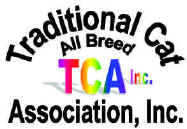
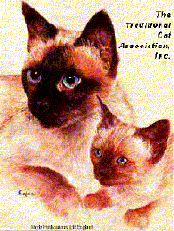 The
Traditional Cat Association,
Inc.©1987®TM
Official Website
The
Traditional Cat Association,
Inc.©1987®TM
Official Website